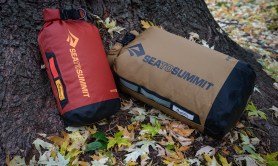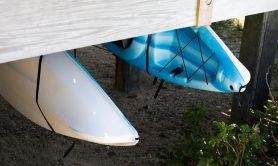

An outdoor adventure is always more enjoyable when you have the right equipment, and that starts with the right clothing.
An insulated jacket is one of the most important items in any closet, so we’re here to explain the subtle differences between two popular types, down and synthetic jackets. The terms “down” and “synthetic” refer to a jacket’s insulation, which is the part of the jacket that traps heat and keeps you cozy and warm.
Both are excellent for keeping you warm in cold weather and have the added practicality of being easy to pack and compress for easy storage and travel.
The key terms:
- Down: Insulation made from the feathers of duck and geese.
- Synthetic: Insulation made from synthetic fibers.
- Loft: The thickness and fluffiness of the insulation layer in a jacket. This directly impacts its ability to trap air and provide warmth.
Which one is best for you? Let’s find out.
This post contains affiliate links. Outdoors.com may earn a commission when you make a purchase through these links. Thank you for your support.
Down Insulation: The Advantages

Lightweight, packable, and easy to wear, a down jacket is essential if you love that classic puffer jacket look, and more importantly, if you plan on spending any time out in the cold.
Down jackets are filled with clusters of duck or goose plumage feathers, which are the finest feathers found closest to the bird’s body. This kind of insulation has an effective warmth-to-weight ratio because the feathers trap air pockets that retain body heat. A down jacket is ideal for cold and dry weather.
Fill Power
You can evaluate the efficiency that down insulation provides by checking the fill power. Fill power ratings generally range from 550 to 900. The higher the fill power, the greater the loft and the insulating efficiency. However, other factors can contribute to the overall warmth of a jacket, such as the fill weight.
For activities such as mountaineering or winter camping, a higher fill power is recommended (800+ fill power) for maximum cozy comfort. The higher the fill power, the more compressible the jacket, so that’s something to bear in mind, too.
A jacket with down insulation is also lightweight and compressible, making it easy to pack into a stuff sack or tuck into a pocket when you are not wearing the jacket. It will not weigh much in your pack if you want to carry it with you for a while when hiking. This is a reason why down is also used for sleeping bags.
Find more suggestions on our list of the best packable down jackets.
Down Jackets: The Disadvantages
However, one of the main disadvantages of down is that it loses its insulation properties when it gets wet. The feathers clump together and lose their loft. The garment becomes unable to trap air effectively and the jacket will become heavier and cumbersome to wear or carry. It can also take a long time for the jacket to completely dry out.
It is possible to mitigate this issue by wearing a waterproof outer layer or rain jacket and using the down jacket as a mid-layer, which can be a very effective way of dressing in inclement weather conditions. Learn more about how to layer for winter hiking.
If you are looking for a jacket with additional features, check out our list of the best hiking jackets.
From time to time, feathers can escape through the seams of a down jacket. The outer shell will usually be made from strong materials, but unfortunately, these things happen sometimes. This is why checking the quality of stitching is important before you purchase.
Minor tears or punctures in the outer shell of a down jacket or down sleeping bag can often be repaired by using a patch kit specifically designed for outdoor gear.
For more extensive damage or issues with the insulation, it may be necessary to seek advice from the manufacturer or take the jacket to a specialized outdoor gear repair shop.
Synthetic Insulation: The Advantages

Synthetic fibers, such as nylon or polyester, work in a similar way that mimics down insulation.
Synthetic fill is often designed using a variety of shapes and sizes to enhance its insulating properties. Some fibers feature hollow cores that further enhance their capabilities for trapping air, creating better thermal efficiency.
A jacket with synthetic insulation is a better choice for wet conditions because it can still retain heat while wet, whereas down insulation loses its insulating properties when wet.
Synthetic fibers are hypoallergenic, which makes it a good choice for anyone with sensitivity to down or feathers. Also, it is a good option for those who would prefer to avoid clothing made using animal products.
Synthetic Jackets: The Disadvantages
Synthetic jackets are slightly heavier and bulkier than down jackets.
They have a lower warmth-to-weight ratio, which means that it requires more insulation material to achieve the same warmth as a down jacket. It might not offer the same longevity as a down jacket, since the insulation compresses and loses its loftiness over time.
Synthetic fibers can be less breathable than down, and they also retain odors when exposed to sweat or moisture. This might not be ideal if you are planning to wear the jacket for strenuous outdoor activities.
In terms of sustainability, there are downsides to the production of both down and synthetic jackets. For synthetic materials, many brands are making a conscious effort to make the process more sustainable by using materials such as recycled polyester. However, it’s worth noting that most synthetic materials are still derived from petroleum-based sources.
The Best Down and Synthetic Jackets
- Down Jacket: Arc’teryx Cerium Down Hoodie – Men’s and Women’s
- Synthetic Jacket: RAB Cirrus Flex 2.0 Hooded Jacket
Frequently Asked Questions
What is a jacket’s outer shell made from?
The outer shell of both down and synthetic jackets is typically made from durable, weather-resistant materials such as nylon, polyester, or ripstop fabrics.
These materials are chosen to provide protection against the elements while maintaining breathability and comfort for the wearer during outdoor activities. Some are treated with a DWR (Durable Water Repellent) finish to repel moisture.
Which type of insulation is more expensive?
The cost of the jacket will vary depending on the brand, but in most cases, a down jacket with a high fill power is likely to cost more than a synthetic jacket.
The process in creating high-quality down insulation is a detailed manufacturing process. The natural feathers are sourced from ducks or geese, so they need to be cleaned and treated properly, as well as quality checked, before they can be used.
Down jackets, when cared for properly, are also thought to last longer, which also increases the cost.
Which brands are best?
You can’t go too far wrong with respected outdoor clothing brands, such as Rab, Jack Wolfskin, and The North Face. Brands such as Marmot offer great hiking jackets at a reasonable price.
If in doubt, always read user reviews when you are shopping online. It is a great way to find out information about the product, including how long it lasts over time. Important details about the fit and sizing will also help you to make a decision.
You can also purchase in-store, which is a good way to try on a garment and check the fit and style, as well as investigate some of its features, such as stitching, fabric quality, and lining. Go to REI Co-Op or Dick’s Sporting Goods to shop their range of down or synthetic jackets in store.

Down vs. Synthetic Jacket, Which Do You Choose?
Both down and synthetic jackets are excellent choices for cold-weather activities. Whatever you choose, you’ll be grateful for the extra layer of insulation so you can enjoy your favorite adventures to the fullest.









